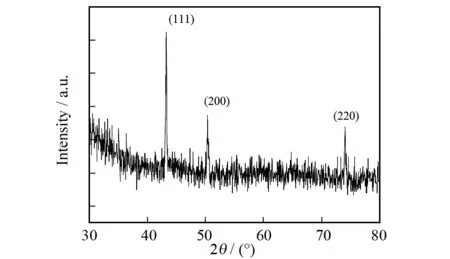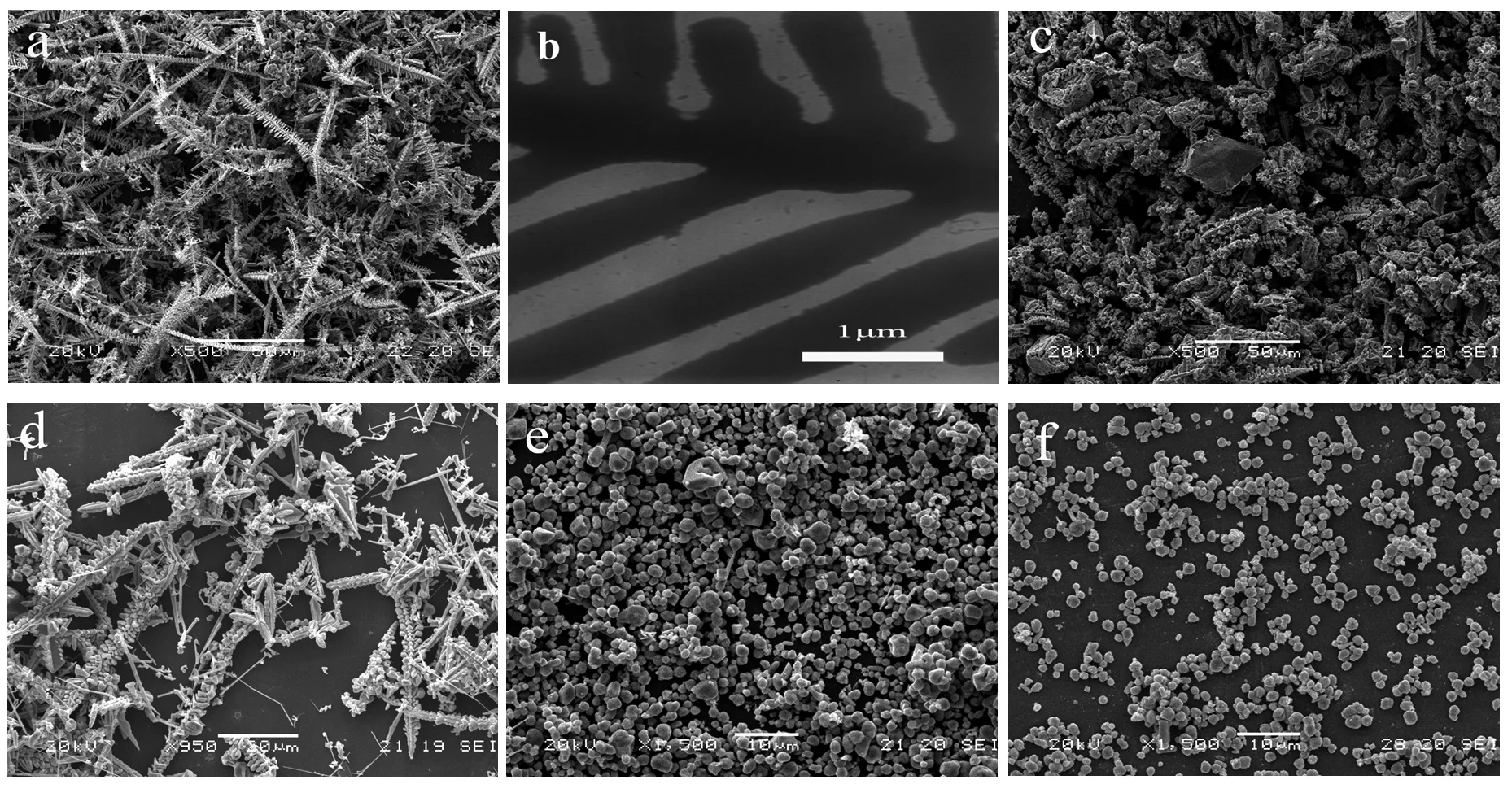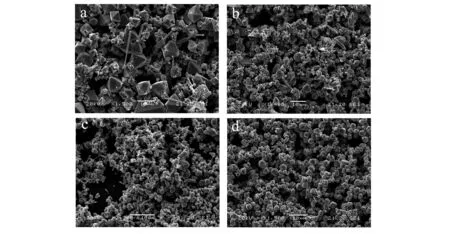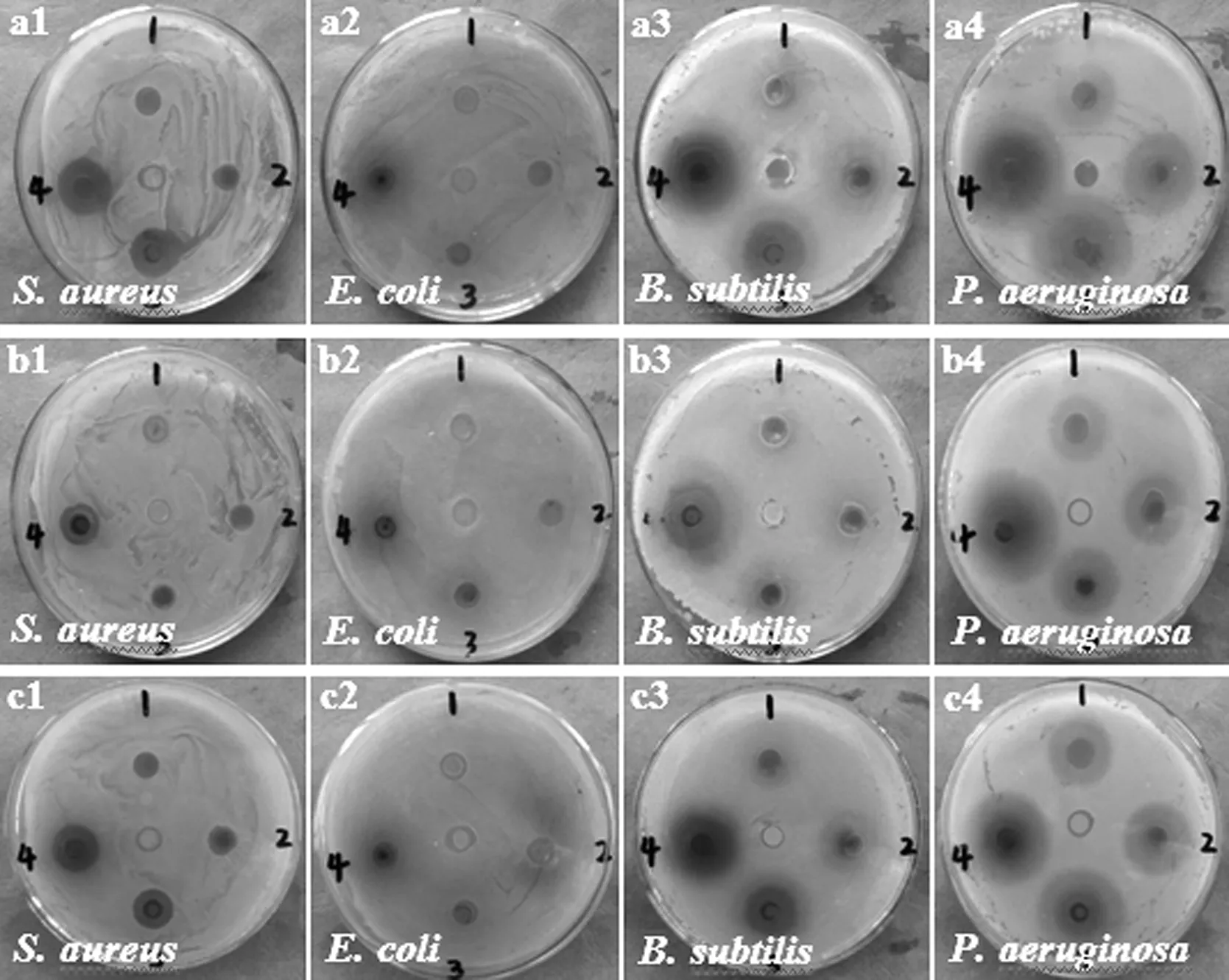铜树枝晶的水热合成以及结构表征和抗菌性能评价
2014-09-02曹刘琴冷春丽李园园赵彦保李宾杰
曹刘琴,冷春丽,李园园,赵彦保*,李宾杰
(1. 河南大学 化学化工学院, 河南 开封 475004; 2. 河南大学 特种功能材料重点实验室, 河南 开封 475004; 3. 河南大学 免疫研究所, 河南 开封 475004)
铜树枝晶的水热合成以及结构表征和抗菌性能评价
曹刘琴1,冷春丽1,李园园2,赵彦保2*,李宾杰3
(1. 河南大学 化学化工学院, 河南 开封 475004; 2. 河南大学 特种功能材料重点实验室, 河南 开封 475004;
3. 河南大学 免疫研究所, 河南 开封 475004)
在乙醇胺-水混合溶液中采用水热处理硫酸铜的方法制备了多结构的铜树枝晶;采用X射线粉末衍射仪、扫描电子显微镜、透射电子显微镜分析了所得样品的结构和形貌;采用牛津杯法评价了其对金黄葡萄球菌、枯草芽孢杆菌、大肠杆菌和绿脓杆菌的抗菌性能. 结果表明,铜树枝晶由一个长的一级中心主干和许多高度对称分布在主干两侧的二级分支结构构成,且形貌均匀;反应温度、反应时间以及溶剂组成对铜树枝晶的形貌有很大影响. 与此同时,铜树枝晶表现出选择性的抗菌行为,对金黄葡萄球菌、枯草芽孢杆菌和绿脓杆菌更有效.
铜树枝晶;水热合成;结构表征;抗菌性能;评价
Metal micro/nanostructures (MMNSs) have attracted tremendous interest, due to their fascinating properties and promising applications in microelectronics, catalysis, biological labeling, photonics, and magnetic ferrofluids[1]. The physical and chemical properties of MMNSs are highly dependent on their size, shape, composition, crystallization and structure. Therefore, many efforts have been made in the past decades to synthesize MMNSs with controllable morphologies[2]. To date, MMNSs with different shapes, including rods[1-2], wires[3-5], cubes[6-8], spheres[9], triangles[10-14], hexagons[15-16], flowers[17-20]and dendrites[21-23], have been successfully prepared. Particularly, dendrite, consisting of a main stem and many side branches, exhibits a hierarchical structure and has attracted much attention for both fundamental studies and potential applications.
Among various metal dendrites, copper dendrites are significant with superior performance and inexpensive source, and many methods including liquid phase reduction[24], electrochemical deposition[25-27], and replacement reaction[28-29]have been used to synthesize copper dendrites. However, most of these methods suffer from various disadvantages. For example, though electrolytic method is widely used to prepare copper dendrites, it is costly and complicated, while copper dendrites synthesized by liquid reduction method are not uniform and liable to oxidation in washing process. As compared with conventional synthetic techniques, hydrothermal method is becoming increasingly popular, due to the mild conditions and facile process[30-31].
Viewing the aforementioned perspectives, we pay special attention to Cu, in particular, nanosized Cu, as an antibacterial agent[32-33]. Noticing that ethanolamine (EA) belongs to alcamines and may exhibit similar modifying effect for copper MMNSs as DEA does, here we adopt a hydrothermal route in EA/water solution to prepare symmetrical copper dendrites. This article reports the synthesis of the title Cu dendrite as well as its structure characterization and antibacterial activity againstBacillussubtilis(B.subtilis),Staphylococcusaureus(S.aureus),Escherichiacoli(E.coli) andPseudomonasaeruginosa(P.aeruginosa).
1 Experimental
1.1 Materials and synthesis
Copper sulfate (Tianjin Basf Chemical Company), ethanolamine (Tianjin Kermel Chemical Reagent Company), triethanolamine (TEA, Tianjin Kermel Chemical Reagent Company), and sodium hypophosphite (Tanggu Xinhua Chemical Factory) are all analytical pure reagents and were used without further purification. Nutrient broth (NB, BR) and nutrient agar (NA, BR) were received from Beijing Aoboxing biotech Company. Gram-positiveStaphylococcusaureus(S.aureus, ATCC 35696) andBacillusSubtilis(B.subtilis, ATCC 21332) as well as Gram-negativePseudomonasaeruginosa(P.aeruginosa, ATCC 27853) andEscherichiacoli(E.coli, ATCC 23282) were selected as experimental strains.
Typically, 0.25 g of anhydrous copper sulfate and 0.2 g of sodium hypophosphite were dissolved in distilled water to form a blue transparent solution. Then a certain volume of EA or TEA was added to above solution under stirring condition to form homogenous solution. Finally, the homogenous solution was transferred into a 50 mL steel autoclave, sealed and maintained at 140 ℃ for 12 h. Upon completion of the reaction, the solution was cooled naturally, centrifuged and washed to afford desired copper products.
1.2 Characterization
The crystallographic structure and phase purity of as-prepared copper dendrites were examined by X-ray diffraction (XRD; X’Pert Philips diffractometer, Cu-Kαradiation,λ= 0.154 06 nm, operating at 40 kV and 40 mA). The morphology and particle size were characterized by transmission electron microscopy (TEM, JEOL JEM100CX-П) and scanning electron microscopy (SEM, JEOL JSM5600LV, 20 kV), respectively.
1.3 Antibacterial activity test
In order to investigate the antimicrobial ability of copper crystals, we employed Oxford-cup method as follows.S.aureus,B.subtilis,E.coliandP.aeruginosawere selected as test strains. All the disks and materials were sterilized in an autoclave before experiments, and experimental operations were conducted in super clean bench. Firstly, the melted sterilized LB agar medium was poured into Petri dishes and then solidified. Secondly, the medium containing bacteria (108CFU/mL) was uniformly layered over LB agar plates, respectively. Thirdly, sterilized Oxford cups were gently placed on the lawn of bacteria in LB agar plates. Finally, different concentrations of suspensions of cuprous oxides were dripped into Oxford cups. Meanwhile, 0.9% of sterilized physiological saline was dropped into the central cup and used as contrast sample. Afterwards, they were incubated at 37 ℃ for 24 h. Antibacterial activity was evaluated by measuring the diameter of transparent circles around the Oxford cups.
2 Results and discussion
2.1Morphologicalandstructuralcharacterization
Fig.1 displays the XRD pattern of as-synthesized copper dendrites. Three prominent peaks at scattering angles (2θ) of 43°, 50° and 74° are assigned to the (111), (200) and (220) crystal planes of face-centered cubic copper, respectively. Furthermore, no characteristic peaks of impurities of copper oxides were detected, which indicates that pure copper dendrites can be obtained under current synthetic condition.

Fig.1 XRD pattern of copper dendrites
Fig.2 gives typical SEM and TEM images of the Cu dendrites prepared in EA/H2O (volume ratio 5/35) at 140 ℃ for 12 h. It is seen that the copper products have uniform dendritic morphology, and the dendrites consist of a long primary central stem and many highly ordered secondary branches distributed evenly on both sides of the stem (Fig.2a). Besides, some rods and particles are also obtained. More details of the morphology and microstructure of as-synthesized Cu dendrites are given in Fig.2b and Fig.2c. It can be seen that the individual dendrite has a length of about 100 μm, and the secondary branches parallel to each other and deflect away from the stem by 60°. The secondary branch has a length of 2-7 μm and a width of 0.3-1.0 μm, and longer branches are made of two intercrossing microsheets. Fig.2d shows the TEM image of a single dendrite. It is seen that there is no interface between the microsheets, which confirms that the products have perfect dendritic structure.
2.2 Effect of reaction temperature
It is well-known that the reaction conditions such as reaction temperature, reaction time, dosage and kinds of regents have important influences on the morphology of Cu products obtainedviahydrothermal route. Fig.3 shows the SEM images of copper dendrites obtained at different temperatures and a fixed time as well as EA/water volume ratio of 5/35. When reaction temperature is increased to 160 ℃, as-obtained samples mainly consist of dendritic structure which is similar to that of the dendrites prepared at 140 ℃. Similar result is also obtained when the temperature is increased to 180 ℃, in association with the formation of some tertiary branches. Thus, the temperature range suitable for the hydrothermal synthesis of Cu dendrites is suggested as 140-180 ℃.


Fig.2 SEM and TEM images of copper dendrites obtained under the standard condition: VEA/Vwater = 5/35, 140 ℃, 12 h (a) Low-magnification SEM image of copper dendrites, (b) and (c) High-magnification SEM images, and (d) TEM image of copper dendrites

Fig.3 SEM images of copper dendrites obtained at different temperatures ((a) 140 ℃, (b) 160 ℃, and (c) 180 ℃) and a fixed EA/H2O volume ratio of 5/35
2.3 Effect of EA/H2O volume ratio

(a) VEA/VH2O = 5/35, (b) TEM image of dendrites in Fig.4a, (c) VEA/VH2O = 10/30, (d) VEA/VH2O = 20/20, (e) VEA/VH2O = 30/10, and (f) VEA/VH2O = 35/5.Fig.4 SEM images of copper products obtained at different dosage of EA at 160 ℃ for 12 h
EA molecules have strong chelating ability to copper atoms, so it is believed that the volume ratio of EA/H2O would have a significant modifying effect on the morphology of copper MMNSs. Fig.4 gives the SEM and TEM images of copper samples obtained under different EA/H2O volume ratio at 160 ℃ for 12 h. When the volume ratio of EA/H2O is 5/35, as-obtained products mainly have dendritic structure (see Figs.4a and 4b). When EA/H2O volume ratio is increased to 10/30, as-obtained samples coexist in the forms of octahedron, porous particles and dendrites (Fig.4c). When the ratio of EA/H2O is 20/20, the samples have dendrite structure composed of sphere-like particles on the surface of rods; and in this case, the length of the dendrites is in the range of 10-40 μm, and thier diameter is in the range of 2-6 μm (Fig.4d). When EA/H2O volume ratio is larger than 30/10, the major samples are particles (Figs.4e and 4f). These results indicate that the EA/H2O volume ratio of 5/35 is favorable for the formation of copper dendrites.
2.4 Effect of reaction time
To understand the evolution of copper dendrites, we conducted time-dependent experiments at 160 ℃ with EA/H2O volume ratio of 5/35. Fig.5 gives the SEM images of resultant Cu dendrites prepared at different reaction time. When the reaction time is 4 h, the product mainly consists of three different forms of copper MMNSs, including particles, rods and dendrites. The dendrites have shorter branches, and there are some particles at the surface of the rod (Fig.5a), which indicates that the branches are grown out from the surfaces of the rods. When the reaction time is 6 h, similar results are obtained (Fig.5b). Besides, it is obvious that the symmetrical secondary branches grow out of the stem when the reaction time rises to 10 h (Fig.5c); and further extending reaction time leads to the formation of uniform dendrites (Fig.4a).

Fig.5 SEM images of copper dendrites obtained at different time ((a) 4 h, (b) 6 h, and (c) 10 h) under 160 ℃ and VEA/VH2O = 5/35
2.5 Effect of TEA dosage
Both TEA and EA belong to alcamine, so TEA would also affect the morphology of copper products in the hydrothermal process. Fig.6 shows the SEM images of copper samples prepared with different TEA/H2O volume ratio at 140 ℃ for 12 h. When the volume ratio of TEA/H2O is 5/35, the major samples are Cu octahedrons with a size of 10 μm, which is different from the case of EA. The surfaces of Cu octahedrons are smooth, and some cavities at the surface of Cu octahedron are also observed (Fig.6a). Besides, there also exist some octahedrons consisting of particle aggregations. When the volume ratio of TEA/H2O is larger than 30/10, the samples are mainly particles, which indicates that the TEA/H2O volume ratio of 5/35 is favorable for the formation of copper octahedrons, though some octahedrons are partly broken.

(a) VTEA/VH2O = 5/35, (b) VTEA/VH2O = 10/30, (c) VTEA/VH2O = 30/10, (d) VTEA/VH2O = 35/5Fig.6 SEM images of copper samples prepared at different TEA/H2O volume ratio at 140 ℃ for 12 h
2.6 Antibacterial activity
Fig.7 shows the antibacterial ability of Cu dendrites (a), octahedrons (b) and particles (c) towardsS.aureus,B.subtilis,E.coliandP.aeruginosadetermined by Oxford cup method. Here, the concentrations of sample are 2, 4, 8 and 16 g/L, corresponding to the number from one to four, respectively. For comparison, 0.9% of saline is used as the central sample. ForS.aureus,B.subtilisiandP.aeruginosa, after 24 h of incubation, there appear clearly visible zone of inhibition on agar plates in the tested concentration range. As the additive concentration increases, the inhibition zones are evidently increased, which indicates that the three samples have better antibacterial ability at higher concentrations. As toE.coli, three samples display weak antibacterial activity, which indicates thatE.colimay be a Cu-tolerant bacterium.

Fig.7 Pictures of antibacterial ability test of Cu dendrites (a), octahedrons (b) and particles (c) towards four kinds of strains by Oxford cup method. The concentrations of samples are 2, 4, 8 and 16 g/L, respectively, corresponding to the number from one to four. The central contrast sample is 0.9% of saline
3 Conclusions
A hydrothermal method is adopted to synthesize micrometer copper dendrites through reducing cupreous sulfate with sodium hypophosphite. Reaction condition tests in association with morphology and structure characterization of as-synthesized products demonstrate that reaction conditions have great influences on the morphologies and particle sizes of the products, and smaller EA/H2O volume ratio is beneficial to affording desired copper dendrites. Besides, as-obtained Cu crystals exhibit selective antibacterial activities towards various strains under investigation. Namely, they display effective antibacterial activity againstS.aureus,B.subtilisandP.aeruginos; whileE.colimay be a Cu-tolerant bacterium.
[1]ZHANG Xiaojun, ZHANG Dongen, NI Xiaomin, et al. One-step preparation of copper nanorods with rectangular cross sections [J]. Solid State Commun, 2006, 139: 412-414.
[2]CHEN H M, LIU R S, TSAI D P. A versatile route to the controlled synthesis of gold nanostructures [J]. Cryst Growth Des, 2009, 9(5): 2079-2087.
[3]SUN Y G, YIN Y D, MAYERS B T, et al. Uniform silver nanowires synthesis by reducing AgNO3with ethylene glycol in the presence of seeds and poly(vinyl pyrrolidone) [J]. Chem Mater, 2002, 14(11): 4736-4745.
[4]SUN Yugang, XIA Younan. Large-scale synthesis of uniform silver nanowires through a soft, self-seeding, polyol process [J]. Adv Mater, 2002, 14(11): 833-837.
[5]MOHL M, PUSZTAI P, KUKOVECZ A, et al. Low-temperature large-scale synthesis and electrical testing of ultralong copper nanowires [J]. Langmuir, 2010, 26(21):16496-16502.
[6]SUN Yugang, XIA Younan. Shape-controlled synthesis of gold and silver nanoparticles [J]. Science, 2002, 298: 2176-2179.
[7]WANG Yihai, CHEN Penglei, LIU Minghua. Synthesis of well-defined copper nanocubes by a one-pot solution process [J]. Nanotechnology, 2006, 17: 6000-6006.
[8]JIN Mingshang, HE Guannan, ZHANG Hui, et al. Shape-controlled synthesis of copper nanocrystals in an aqueous solution with glucose as a reducing agent and hexadecylamine as a capping agent [J]. Angew Chem Int Ed, 2011, 50: 10560-10564.
[9]LIN X Z, TENG X W, YANG H. Direct synthesis of narrowly dispersed silver nanoparticles using a single-source precursor [J]. Langmuir, 2003, 19(24): 10081-10085.
[10]JIN R, CAO Y C, HAO E, et al. Controlling anisotropic nanoparticle growth through plasmon excitation [J]. Nature, 2003, 425: 487-490.
[11]YANG Y, MATSUBARA S, XIONG L, et al. Solvothermal synthesis of multiple shapes of silver nanoparticles and their SERS properties [J]. J Phys Chem C, 2007, 111(26): 9095-9104.
[12]TIAN Xuelin, WANG Weihua, CAO Gengyu. A facile aqueous-phase route for the synthesis of silver nanoplates [J]. Mater Lett, 2007, 61(1): 130-133.
[13]HUANG Linjian, ZHAI Yueming, DONG Shaojun, et al. Efficient preparation of silver nanoplates assisted by non-polar solvents [J]. J Colloid Interface Sci, 2009, 331: 384-388.
[14]TAO Xiaojun, SUN Lei, ZHAO Yanbao. Sonochemical synthesis and characterization of disk-like copper microcrystals [J]. Mater Chem Phys, 2011, 125: 219-213.
[15]XU Run, XIE Ting, ZHAO Yonggang, et al. Single-crystal metal nanoplatelets: cobalt, nickel, copper and silver [J]. Cryst Growth Des, 2007, 7(9): 1904-1911.
[16]WANG Xinjun, HAN Kun, WAN Fuquan, et al. Controllable synthesis of submicrometer-sized copper crystallites with different morphologies [J]. Mater Lett, 2008, 62: 3509-3511.
[17]MULVIHILL M J, LING X Y, HENZIE J, et al. Anisotropic etching of silver nanoparticles for plasmonic structures capable of single-particle SERS [J]. J Am Chem Soc, 2009, 132(1): 268-274.
[18]JIANG Yuanyuan, WU Xuejun, LI Qi, et al. Facile synthesis of gold nanoflowers with high surface-enhanced Raman scattering activity [J]. Nanotechnology, 2011, 22: 385601 1-6.
[19]LUO Huajuan, ZHAO Yanbao, SUN Lei. Synthesis and characterization of micrometer Cu/PVP architectures [J]. Mater Res Bull, 2011, 46: 1151-1156.
[20]JIANG Changlong, ZHANG Wangqun, LIU Yankuan, et al. Self-assembled copper nanowalls into microstructures with different shapes: a facile aqueous approach [J]. Cryst Growth Des, 2006, 6(11): 2603-2606.
[21]RASHID M H, MANDAL T K. Synthesis and catalytic application of nanostructured silver dendrites [J]. J Phys Chem C, 2007, 111(45): 16750-16760.
[22]FANG Jixiang, YOU Hongjun, KONG Peng, et al. Dendritic silver nanostructure growth and evolution in replacement reaction [J]. Cryst Growth Des, 2007, 7(5): 864-867.
[23]XIE Shunping, ZHANG Xicui, XIAO Dan, et al. Fast growth synthesis of silver dendrite crystals assisted by sulfate ion and its application for surface-enhanced raman scattering [J]. J Phys Chem C, 2011, 115: 9943-9951.
[24]LI Zhongchun, ZHOU Quanfa. PEG-6000 assisted growth of copper dendrites [J]. J Dispersion Sci Technol, 2010, 31: 1401-1405.
[25]QIU R, CHA H G, NOH H B, et al. Preparation of dendritic copper nanostructures and their characterization for electroreduction [J]. J Phys Chem C, 2009, 113: 15891-15896.
[26]XU Jianwen, YU Ke, ZHU Ziqiang. Synthesis and field emission properties of Cu dendritic nanostructures [J]. Phys E, 2010, 42: 1451-1455.
[27]WANG R C, LI C H. Cu, Cu-Cu2O core-shell, and hollow Cu2O nanodendrites: Structural evolution and reverse surface-enhanced Raman scattering [J]. Acta Mater, 2011, 59: 822-829.
[28]SUN Shaodong, KONG Chuncai, WANG Liqun, et al. Nanoparticle-aggregated paddy-like copper dendritic nanostructures [J]. CrystEngComm, 2010, 13: 1916-1921.
[29]JI Zhuoyu, LI Hongxiang, LIU Yaling, et al. The replacement reaction controlling the fractal assembly of copper nanoparticles [J]. Nanotechnology, 2008, 19: 135602 (5pp).
[30]ZHANG Zhiyu, HU Chenguo, FENG Bin, et al. Growth of dendritic copper nanocrystals in alkaline solution [J]. J Supercond Nov Magn, 2010, 23: 893-895.
[31]HU Chaoquan, GAO Zhenghong, YANG Xiaorui. A facile hydrothermal route to synthesis of nonporous and porous hierarchical copper dendrites [J]. J Cryst Growth, 2007, 306: 390-394.
[32]CHATTERJEE A K, SARKAR R K, CHATTOPADHYAY A P, et al. A simple robust method for synthesis of metallic copper nanoparticles of high antibacterial potency againstE.coli[J]. Nanotechnology, 2012, 23: 085103-085113.
[33]RAFFI M, MEHRWAN S, BHATTI T M, et al. Investigations into the antibacterial behavior of copper nanoparticles againstEscherichiacoli[J]. Ann Microbiol, 2010, 60: 75-80.
date:2013-12-20.
Supported by the Natural Science Foundation of China (21271062) and the Construction Fund of Department of Education of Henan Province( SBGJ090515).
Biography:CAO Liuqin (1972-), female, experimentalist, majoring in material chemistry.*
, E-mail: zhaoyb902@henu.edu.cn.
